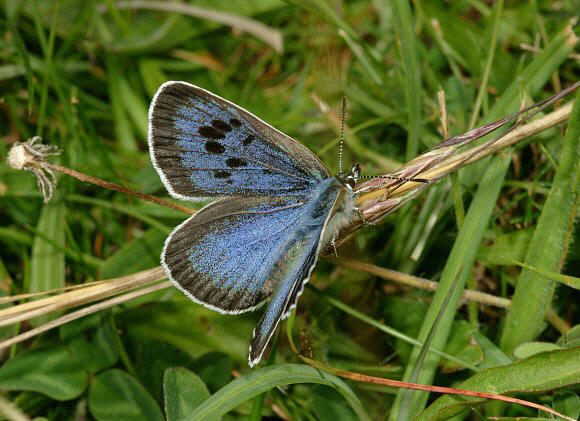 Large Blue Maculinea arion, female, Collard Hill, Somerset – Adrian Hoskins
Large Blue Maculinea arion, female, Collard Hill, Somerset – Adrian Hoskins
Introduction
The Large Blue is widely distributed across Europe, but absent from southern Spain, Portugal, northern Scandinavia, and most Mediterranean islands. It’s range also includes Turkey, Russia, western Siberia, Mongolia, temperate China and Japan.
Since the discovery of the first British colony in 1795, the butterfly has always been considered a rarity. In the 19th century, collectors searched far and wide, successfully locating colonies at sites including the cliffs of Dover, Marlborough Downs, Winchester, Somerset, the Cotswold hills, south Devon, Buckinghamshire, and at Barnwell Wold in Northamptonshire.
Butterfly collecting was an obsession among the middle classes during the Victorian period, and the Large Blue was regarded as a major trophy which could be sold for substantial profit. As a direct result most colonies were exterminated by collectors. By 1950 only 30 sites remained. The spread of myxomatosis then caused the collapse of rabbit populations, and as a consequence the sites quickly became under-grazed, and the microclimate became too cool to support the ant Myrmica sabuleti, with which the butterfly has a symbiotic relationship. By 1970 only 3 or 4 colonies survived, all on nature reserves. Populations however continued to decline dramatically, and the Large Blue became extinct in Britain in 1979.
In the 1980’s, following extensive research into the butterfly’s ecology by Dr Jeremy Thomas, plans were laid to reintroduce the butterfly using livestock imported from Sweden. These reintroductions, mostly on private nature reserves, met with varying degrees of success.
At the time of writing (2012) the Large Blue has become successfully re-established at several sites in Devon and Somerset, and it’s future in Britain, at least in the short term seems assured.
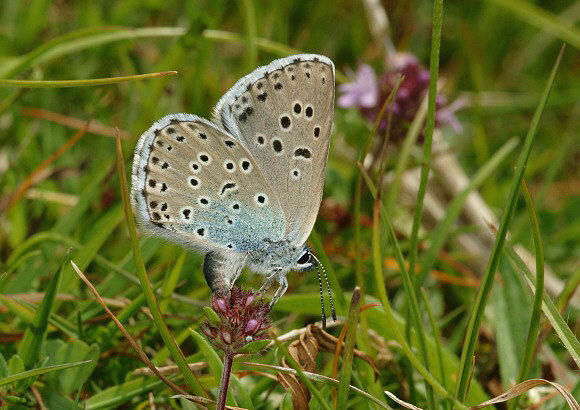 Large Blue ovipositing ( note egg already laid on lower right of thyme flower ), “site H”, Somerset
Large Blue ovipositing ( note egg already laid on lower right of thyme flower ), “site H”, Somerset
Habitats
In Europe the butterfly can be found in a wide variety of habitats including coastal cliffs, limestone gorges, stony plateaux, and alpine pastures. In France for example I have found colonies as high as 2000m in Vanoise National Park, at 1500m on Mont Dore in the Massif Central, and at roadside verges and woodland glades at Causse de Gramat.
In Britain the butterfly is confined to a small number of dry calcareous grassland hills in Devon and Somerset, where thyme grows in profusion, and where the microclimate is warm enough to allow the ant Myrmica sabuleti to flourish. Maintaining these conditions normally requires a program of cattle and / or sheep grazing. The butterfly also benefits from the presence of a limited amount of scrub, typically gorse or hawthorn, and thrives best where sheltered areas of long grass are available for roosting.
Colonies everywhere tend to be small, typically less than 20 adults, but I know of well managed sites where up to 70 butterflies can be seen in a day, distributed over an area of several hectares. Population densities normally vary between 2 – 10 butterflies per hectare, but can be as high as 50 per hectare where conditions are ideal.
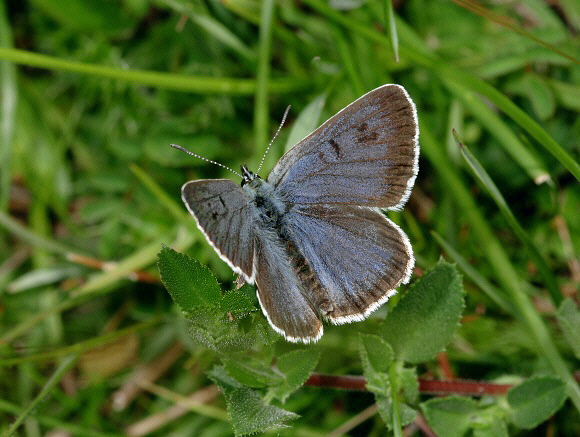 Large Blue Maculinea arion, male, “site H”, Somerset – Adrian Hoskins
Large Blue Maculinea arion, male, “site H”, Somerset – Adrian Hoskins
Lifecycle
The butterfly emerges in June, or sometimes in early July. The entire flight period in Britain spans about 40 days, with individual butterflies living for up to 2 weeks, although the average lifespan is only about 5 days.
The pale bluish-white eggs are laid singly on the flower buds of various plants in the family Labiatae – favouring marjoram in lowland areas of France, but usually selecting thyme Thymus pulegioides in the Alps and in Britain. Females usually choose plants which have several open florets. It is possible to find several eggs on the same flowerhead, but these will have been laid by different females, or on return visits by a single female.
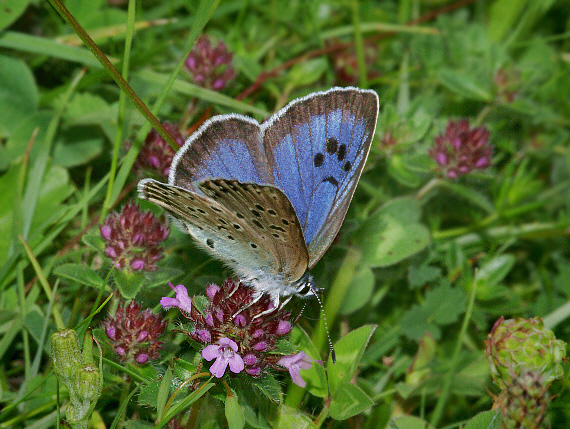 Large Blue Maculinea arion, female, “site H”, Somerset – Adrian Hoskins
Large Blue Maculinea arion, female, “site H”, Somerset – Adrian Hoskins
At one of the British sites, in June 2007 I observed 2 different females ovipositing on the flowerbuds of self-heal Prunella vulgaris. This plant is closely related to thyme but unfortunately the larvae are unable to survive on it for more than a few days and invariably die.
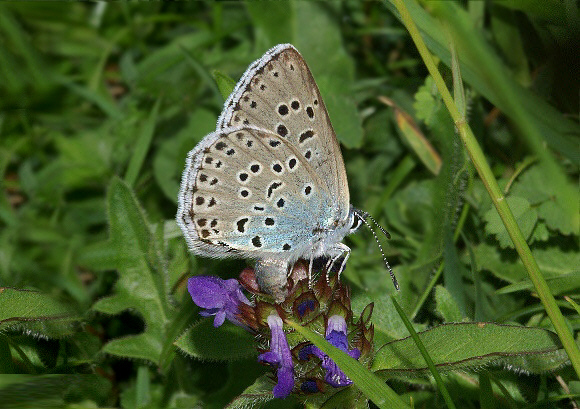 Large Blue Maculinea arion, female ovipositing on self heal, “site H”, Somerset – Adrian Hoskins
Large Blue Maculinea arion, female ovipositing on self heal, “site H”, Somerset – Adrian Hoskins
The caterpillars hatch after 7-8 days, and begin feeding on the flower sepals, on which they are well camouflaged. They eat holes in the sepals to enable them to reach and feed upon the developing seeds. Each larva needs to eat every seed on the flower-head if it is to survive to the fourth instar, and will eat attack any competing caterpillar that it encounters, and eat it to ensure that it has sole access to all the seeds on the plant.
Upon reaching the fourth ( final ) instar it loses interest in feeding, becomes restless, and eventually releases it’s grip on the foodplant and falls to the ground. It wanders about until it is located by an ant of the species Myrmica sabuleti or M. scabrinodis. The ant then begins to caress the larva with it’s antennae. This stimulates the larva to secrete a honey-like fluid from the “Newcomer’s gland” on it’s back. After drinking the honey the ant wanders off, but returns later with other ants to further “milk” the larva.
After several milking sessions the larva becomes immobile, hunching it’s back, and allows an ant to seize it and carry it into the brood chamber of the ant nest. Once settled in its new home the larva becomes carnivorous, feeding on tiny ant grubs. Only the largest ant nests produce the 1500 or so grubs that are necessary for the Large Blue larva to complete its growth.
The larva is tolerated and protected by the adult ants in exchange for providing them with a regular supply of “honey” from it’s dorsal gland. It is also likely that the larva emits pheromones which appease the ants and assure its safety.
| Research on the closely related European species Maculinea rebeli has shown that its larvae are parasitised by the wasp Ichneumon eumerus. The wasp enters the ant brood chamber where it releases a chemical which causes the ants to fight among themselves. The larva is thereby rendered defenceless and vulnerable to attack by the wasp. |
In early September the Large Blue larva enters hibernation, remaining quiescent until the following April, when it resumes feeding on the ant grubs. In May pupation takes place within the ants brood chamber, where the pupa is unprotected by any form of cocoon. Like the larva, it exudes “honey”, and is constantly attended by the ants.
Three weeks later the adult butterfly emerges within the nest, but immediately before emergence the pupa produces a rasping “song” which stimulates nearby ants into a frenzy. The butterfly then breaks out of the pupa, and with it’s wings still tiny and limp, crawls along the ant tunnels until it reaches the surface, where it climbs a stem and hangs to expand and dry it’s wings. Throughout this time the highly vulnerable butterfly is constantly surrounded by the ants. They make no attempt to attack it – their presence in fact acts as a very strong deterrent to any other creature that may be considering the Large Blue as it’s next meal. The butterfly almost certainly therefore is able to appease the ants, by releasing a chemical that either warns that it is distasteful, or mimics the smell of something that the ants find repellent or dangerous.
Adult behaviour
The adults fly rapidly over short distances, settling periodically to nectar or to rest with closed wings, on plant stems. They are deceptively strong flyers, and if disturbed they will fly up to 100 metres before settling. I have on several occasions observed Large Blues fly over tall hedges, or attempt to cross open fields, but invariably after a few seconds of investigation the butterflies return to their habitat. In June 2009, I closely followed a particular female at “site H” in Somerset and noted that it’s “home range” extended a distance of almost a kilometre from one end of the site to the other, and that it oviposited on plants right across the site. This site was in fact colonised naturally from a nearby introduced colony, and it is apparent hat the butterfly has excellent powers of dispersal provided that areas of its habitat are contiguous.
In overcast but warm conditions they bask with wings held half open, on bushes or amongst grasses. On sunny mornings both sexes fly along the bottom of slopes, where the very brief courtship flight takes place. The female then settles on a bush or among grasses, followed closely by the male, who crawls alongside her, and then curves his abdomen to make contact. In England and France I have found copulated pairs sitting half way up thistle stems, low down on grass blades, and sitting on bare ground or rocks.
Most nectaring behaviour takes place in the afternoon, when the butterflies settle for a moment here and there to feed at the flowers of marjoram, thistles, thyme, red clover and white clover.
The butterflies roost overnight under bushes, or amongst tall grasses, usually where these occur in sheltered depressions.

Large Blue Maculinea arion, “site H”, Somerset – Adrian Hoskins
